
|
 |

|
 |
S Natarajan and the Melattur Bhagavatamela tradition Anusha Natarajan speaks to him at Melattur on May 26, 2002 e-mail: natarajan_anush@hotmail.com Jul 2002 Between 1561-1614, Achyutappa Nayaka, a ruler of Tanjore belonging to the Nayak dynasty, granted a village Achyutapuram (named after him), now called Melattur, to 501 refugee families of Kuchipudi dancers who migrated to Tamilnadu after the fall of the Vijaynagar Empire. Melattur is a small village 20 km from Thanjavur in Southern Tamilnadu, India. Considered an offshoot of the Kuchipudi dance tradition, Bhagavatamela, a temple ritualistic dance tradition of hereditary male dancers, is based mostly on plays written in Telugu by Melattur Venkatrama Sastry (1743-1809 A.D), a senior contemporary of Thyagaraja, the great saint, singer and composer of South India. He authored 12 dance dramas of which 6 are in vogue today, the most famous being Prahlada Charitamu. The great Bhagavatamela tradition is thus a rare temple theatre art in a unique blend of bhakti (devotion), music, dance and drama and is the only surviving link today in Tamilnadu that connects us with the ancient Sanskrit theatre as prescribed by sage Bharata. The players were originally recruited from the local Brahmin community. The mela's popularity waxed and waned till it stopped completely in 1937. It was at this critical moment that V Ganesa Iyer, grandfather of Natarajan, revived the mela. He presented Markandeya in 1938 in the local Ganesha temple and followed it with Usha Parinayam the following year. In 1940 they shifted the traditional venue to the Varadaraja Perumal temple. The Bhagavatamela natakams of Melattur Venkatarama Sastry are performed annually, facing the sanctum of Lord Varadaraja, the presiding deity of Melattur village as a part of the Sri Narasimha Jayanti Vasantotsav. 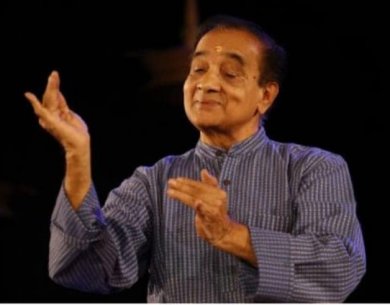 S Natarajan, an electrical engineer from Dubai in the Middle East, has been trained by his father Swaminathan Iyer, grandfather Ganesa Iyer, veteran Balu Bagavathar and K.P. Kittappa Pillai, who composed a set of jathis for Natarajan and named them the Melattur jathis. Natarajan excels in female roles, most notable being Leelavathi in Prahlada Charitamu, Chandramathi in Harischandra, Yasodha in Kamsavadham. Every year, Natarajan travels from Dubai to Melattur for the purpose of staging the Bhagavatamela festival in May - June. Melattur Sri Lakshmi Narasimha Jayanti Bhagavata Mela Natya Nataka Sangam was established in 1938. This group led now by Natarajan has completed 62 years of uninterrupted enactment of the Bhagavatamela natakams (dance dramas) in Melattur. On Natarajan's shoulders lies the immense responsibility of keeping the tradition of the Bhagavatamela alive and going. With scant financial backing but blessed with a team of dedicated male dancers who give him excellent support in his endeavors, he and his equally dedicated family members, put in their level best to preserve and maintain this ancient tradition. Thanks to Natarajan's dedicated service to this art, the mela is now famous across the globe. The 62nd Bhagavata Mela Nataka Mahotsav 2002 was presented by the members of SLNJ Bhagavata Mela Natya Nataka Sangam, at Sri Varadaraja Perumal temple, Melattur from the 24th.May to 1st June 2002. Despite 2 all night programs, Mr.Natarajan found time to speak to us about the subject close to his heart. He was very keen to acquaint the readers of NOL with the Bhagavatamela tradition, its glories and travails. How many years has the Bhagavatamela been going on as performance in Melattur? It has been recorded only from 1888, but it has not been continuous. There have been lots of breaks in between. From 1938, we have been performing for the last 62 years. This is the 62nd year. How did your family's association with Bhagavatamela start? In 1938, we started the Sri Lakshmi Narasimha Jayanti Bhagavata Mela Natya Nataka Sangam, since then our family has been involved. My grandfather was very interested in this art and he did not want the art to die. Earlier Telugu families were involved in this, but as I said earlier, it was very sporadic. One year there would be something, followed by 2 or 3 years of inactivity. My father wanted to revive it, and my grandfather gave support. A group of veterans like Balu Bhagavatar, my sister in law's father Ramamurthy Iyer, Gopala Iyer, Ramani Iyer, and my grandfather got together and started this group. Through so many years of performance, what are the changes you witness, on and off stage? I was born in 1943. Even at the young age of 3, it is still fresh in my memory... to be frank with you, it used to be rather crude and quite lacking both in bhakti as well as in art. It was mere performance, that's all. When you say crude, you mean it lacked a definite style or direction? In all respects! Through the years of performance, has there been a change in standard of performance, maybe betterment? Or a commercialization, that sets in any field in the course of time? Has the flavor changed over the years? No. When I was very young, I remember the older members could not take instructions from younger ones. That was the problem. From 1984 onwards, I took over complete direction of everything. As for commercialization, absolutely no. In fact I would say this is the best period for the Bhagavatamelam. That's because we have well trained boys like Srikanth, Vijay, Arvind and Aniruddh and every year, we are getting in 1 or 2 new boys into this. That has really helped and on the music side, we have very young and talented artistes like Narasimhan and Venkatesan called the Thiruvaiyaru brothers. So, all have added to the betterment of the plays. We have even improved a lot on the stage. I can't say that costumes that we are using now are traditional. Of course, I want to switch over to the traditional costumes. I can't afford it right now. Possibly after getting some financial support. Were the traditional costumes stitched or unstitched? Earlier they were unstitched. But we can have them stitched and still preserve their authenticity. What caused the change in costumes to the present wardrobe? Was it convenience in handling? First of all is the investment and then its preservation for a whole year. We could not afford that. Affordability is what caused the change. There is a feeling that the Bhagavatamela and few other dance forms are being influenced greatly by Bharatanatyam, because it's the most prevalent dance form in India right now. How far do you think it is true - if at all it is? Only Prahlada was played in Melattur even till 1938. Nobody has seen what the original style was. The technique that we are following is what we have been doing in Prahlada. Definitely, it will have the influence of Bharatanatyam because that is the most prevalent style in this region. It is a very difficult situation because there is nobody who knows the original format to guide us. Neither are there any records to show us. An onlooker happened to mention that Mr.Kumar's (played Hiranyakashipu in Prahlada Charitamu) style was more Bhagavatamela style while the others tended to lean more towards the Bharatanatyam style. Kumar is doing more of the tandava style while I do more of lasya, the other boys also. Natesa Iyer (one of several bhagvatars of great merit and distinction who contributed towards sustaining this art) has learnt regular Bharatanatyam from dasis. So, definitely he should have also been doing what I am doing. Basically, Balu Bagavathar, who is the one person who had witnessed earlier performances, trained me. I happen to have improvised a little more because his hastha prayogams would be totally different. I have only improved a bit over it. 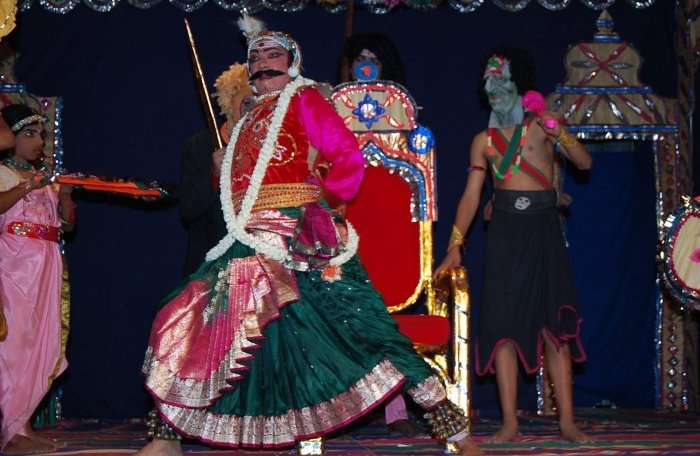
Hiranyakasipu Pravesam, Prahlada Charitam 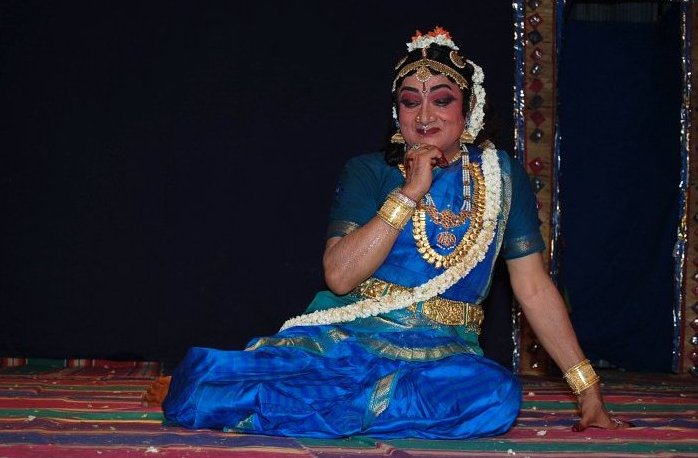 Natarajan as Leelavati 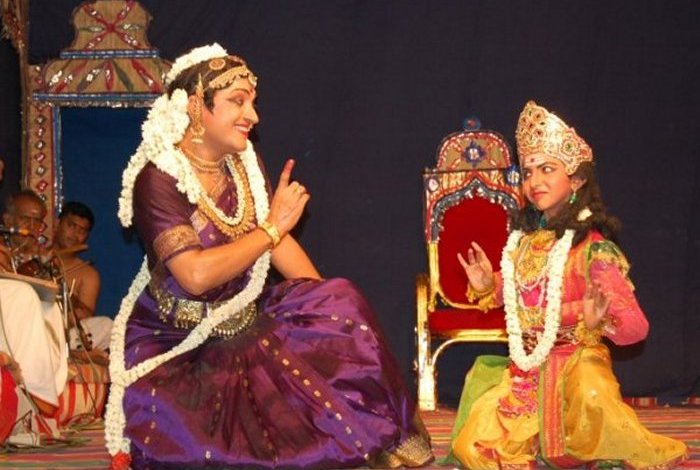
Chandramati Pravesam, Harischandra Natakam 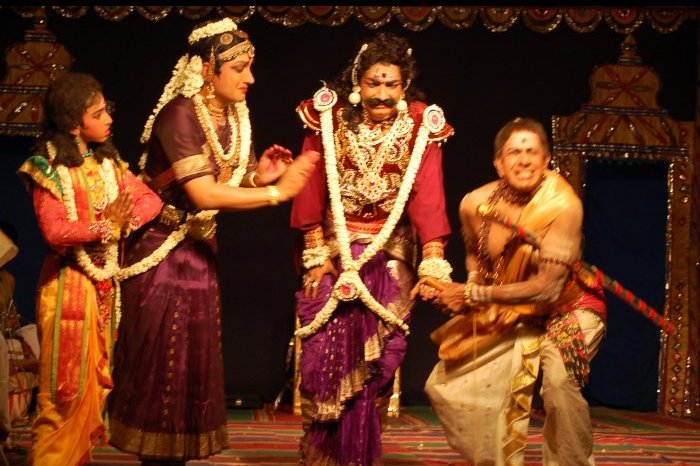 Harischandran tortured by Nakshatriyan As such there is no text that you can follow? No. Is there any influence by the Sopanam music of Kerala in the Bhagavatamela music? No, it is purely classical Carnatic music. Coming from Chennai where we see a surplus of Bharatanatyam recitals, do you think Melattur can present other theater forms like Chakkiyarkoothu, for instance, instead of the Bharatanatyam recitals interspersed with the Bhagavatamela evening programs. Actually, when we had the Golden Jubilee performance in 1990, I invited all these theatre groups and they participated. We had lecture demonstrations, which I have documented. The thing is, we use Bharatanatyam just as an interlude because we cannot perform continuously on all nights. Those days, there used to be no fillers in-between the melam days and the temple would be dark and empty. I did not want that. There should be some performance, like Bharatanatyam, so the younger ones will be motivated. We can get in theater performances, but we cannot afford to pay them. Those who are performing here, all perform for free. I only provide the stage, lights and local hospitality. The repertoire set out by the Tanjore Quartet would be rather recent if compared to the Bhagavatamela tradition. But one is able to observe a similar format in the overall performance of the melam. Could one have been inspired by the other? All the shabdams that are performed in Kuchipudi now, are from Melattur. Ramar Pattabhishekam Shabdam, Mandooka Shabdam are all by Melattur Kasinatha Iyer. All the earliest alarippus (called Mei), javalis and thillanas were from Melattur. Melattur Veerabadraiah was the guru for Ramaswamy Dikshitar who used to come and learn here. What would be the chronology of the emergence of the Bhagavatamela in the 5 villages where it was performed? Matamangalam was 10 years elder to Melattur, but Melattur, Soolamangalam and Oothukaadu followed Melattur script. Matamangalam, Melattur, Saliamangalam, Soolamangalam and Oothukaadu were donated to scholars who migrated from Andhra and settled down here. These were like small colonies. All were devoted to the promotion of art. Not only did dance dramas flourish, even music saw a resurgence. The beauty is that everyone seems to have had their training at Melattur. Even composers at Saliamangalam had their training from Veerabadraiah. Why is Markandeya Charitam not performed very often? Whenever we performed Markandeya, we have lost somebody in the village. It's very powerful; it's definitely a divine art. The make-up for Dharmaraja is not done in the hall, but is done in the middle of the street. After the make-up is over, when he is being escorted to the stage, nobody is allowed to cross his path. So, we keep sentries. I have seen this performed 8 times, and every time somebody passed away. Some of the other plays we perform are Harihara Leela Vilasam (Basmasoora Vadham which is the birth of Ayappa), Harischandra, Usha Parinayam, Rukmini Kalyanam, and Sati Savitri. What is your impression of young dancers today? All the performances that I see in Madras are by very good dancers, they are very talented and very well trained. The only thing is, when they do perform on stage, it is technically good, but it doesn't evoke....it doesn't convey the message that it is supposed to, that particular something is lacking. What is the financial support that the Bhagavatamela depends on? That's a nice question. In the earlier stages, from 1938 to 1952, we were mainly putting in our own resources. My grandfather even sold lots of his lands and managed the expenses. From 1952, we had a small support from the Sangeet Natak Akademi. But that was insufficient. My father was running a grocery store. He diverted all the income from the shop to support this. After I went abroad, I was able to mobilize some funds. For the last few years, we have been getting some support from other sources, like banks and private establishments, so we have been managing somehow. But that is still not enough and a major contribution comes from my family. Conduct of the annual Bhagavata Mela Nataka Utsav and implementation of projects including management of Bhagavata Mela Vidyalaya that imparts systematic training to younger generation to preserve, protect and promote the Bhagavatamela tradition requires huge funds. Banks, establishments, connoisseurs and patrons of music, dance and other performing arts, and ardent devotees are most welcome to contribute their mite for the cause of this divine art form. Though we are getting some additional funds every year, expenses are also escalating, hence we are unable to tie both ends. I am struggling for the past 5 years to get my Trust, tax exemption facility under 80G. 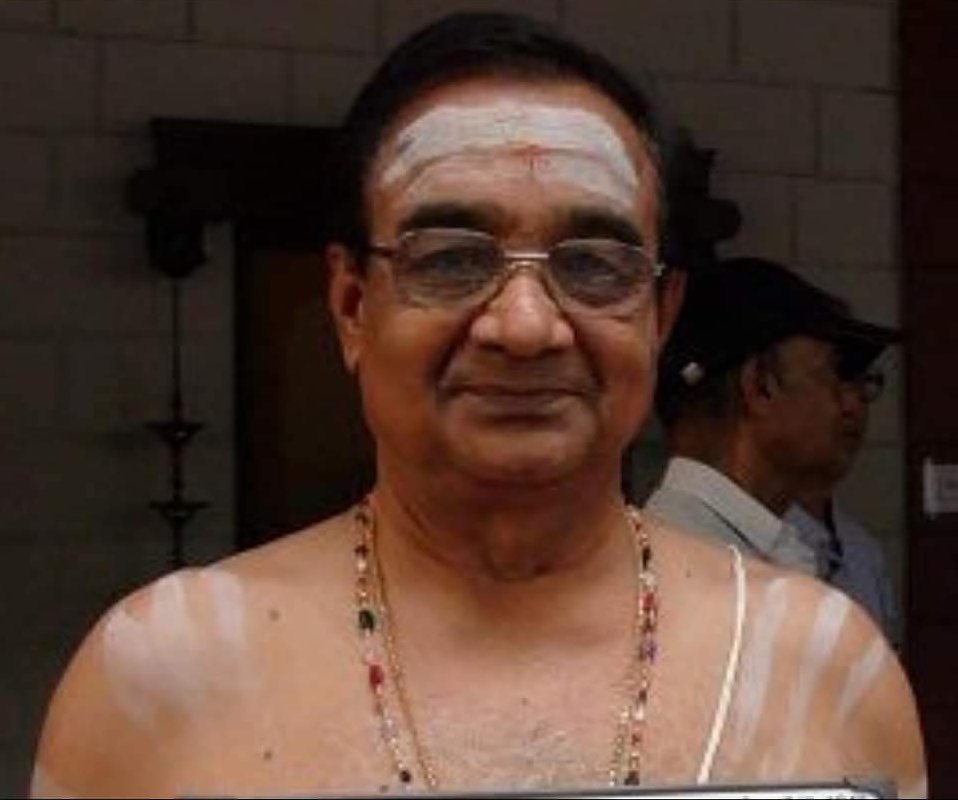 The organization of the Bhagavatamela has been coming down through your family through the years. Do you think, your daughters will continue this tradition? My daughter Priyamvada is a student of Chitra Visweswaran. I have taught her everything. Somebody should know about this. I have done roles in all the plays. So, I have brought in a certain presentation style. I am sure these boys will also uphold the tradition. This is not a family tradition. I will tell you why it was restricted to my family those days. If you see the history in Melattur, the breaks before 1938 were all because of village fractions. If someone were playing some role, some other would not like to join with him. So, it stopped. My grandfather felt it would be better to have all players from one family, so minor differences of opinion could be forgotten during the performance. Thus, it started as a family tradition and it worked out. Now, it is no more restricted and I am taking in other boys. Those days, there was no bhakthi, but I feel there is bhakthi nowadays. Hence these boys will stay with us and propagate this art. It is very difficult for any other person to take up the financial burden. I am trying my level best so we don't have to worry about this. By God's grace, everything should be through within 2 / 3 years. You had mentioned that you want to create a new audience for the melams, of youth, connoisseurs that are sensitive and seeking in knowledge. What is your vision for the future? As far as we know, Venkatrama Shastry has composed 12 plays. We want all the 12 plays to be performed and it should be preserved for the younger generation. Traditionally, the performers are all from Brahmin families. I also want to do the documentation and notate all the songs, so this tradition is preserved for posterity. I don't want this art to die or be lost like the Kuchipudi Yakshagana, which is almost extinct as it has been adapted to a solo form of performance. The Yakshagana tradition is almost gone and I don't want that to happen to Bhagavatamela. Anusha Natarajan is a senior student of the Dhananjayans. |